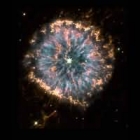"New Nuclei from Old Stars: Observing Trans-Iron Elements in Planetary Nebulae"
Abstract: The picturesque glowing gas clouds called planetary nebulae are the cast-off
outer layers of dying stars similar in mass to our Sun. Although a star is born
with the same chemical make-up as the material from which it formed, as the
star ages and nuclear reactions in its interior synthesize progressively
heavier nuclei, the star's overall composition changes. This chemically
altered material flows back into space via planetary nebulae and other stellar
outflows, causing future generations of stars to start their lives with higher
concentrations of stellar products. Until recently, astronomers were able to
observe only a few of the lightest and most abundant elements in nebulae. In
the past decade we have begun to observe the less-abundant elements beyond Fe,
mainly by means of infrared spectroscopy. I will present results from this new
field of research, focusing on elements with atomic numbers 30 (Zn) through 36
(Kr).

